Let’s do a little thought experiment: Go find a Jace. Any one will do, although it works better with the more expensive ones. Take a good, long look at it. Notice all the details: the hood, the cape, the squiggly glowing runes. That’s what the face of a winner looks like. But what’s his secret? It’s not his diversified stock portfolio; the secret is knowledge. It’s the face of a man who knows more things than his opponents do, and knows those things harder than they do. And now, that knowledge can be yours. Just keep these ten simple practices in mind, and you too can be a Jace.
10. Recycle
9. Save Up
8. Only Hang Out With the Right People
7. Draw Cards
6. Know Your History
5. Always Spend Your Mana
4. Petty Theft
3. Wake Up Early
2. Mono-Red
1. Respect
“Whenever you play a card, draw a card.”
For 4GG and a few other hoops (specifically, shutting off your draw step), this is the benefit Recycle gives us, and the primary reason to play this Tempest enchantment. Its most straightforward application is to fire off lots of small spells, eventually accruing tons of card advantage by drawing more than one card per turn, ideally — but it comes at a cost.
Green is known as the color of extremes: small [card=Llanowar Elves]elves[/card] give way to large [card=Force of Nature]forces of nature[/card], a symbolic representation of natural evolution existing as a microcosm of turns. As anyone who plays Commander will know, with so many decisions being made each turn, the turns begin to resemble epochs of growth and change — fitting for such a theme.
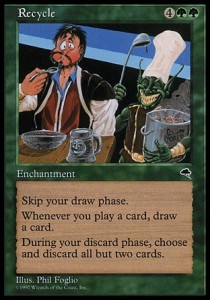
Recycle fits this theme perfectly. By the time turn six has arrived, life has developed on your board, and is blossoming and evolving in many strange ways. So too do your cards evolve: this change now comes quick, as each card played turns into something new and exciting. Life gives way to life.
Similar to Recycle is the card [card]Greater Good[/card]: it helps to draw you cards based not off spells you’re casting, but from the spells you already cast. It features a similar discard mechanic, symbolic of Charles Darwin’s theory of natural selection, in that only the strongest cards survive to stay in your hand.
Each of the five colors approaches this theme differently. Black exchanges life for cards ([card]Phyrexian Arena[/card], [card]Necropotence[/card]), red assumes you want all your cards to be damage spells and offers appropriate sacrifices ([card]Goblin Bomb[/card], [card]Char[/card]), blue trades mana and doing anything else well for cards. White is an outlier, keeping its theme of balance, neutrality, and stasis by not drawing cards at all, as change and evolution are bad for white thematically; instead, it staples card draw onto effects like life gain and small dudes ([card]Renewed Faith[/card], [card]Decree of Justice[/card].)
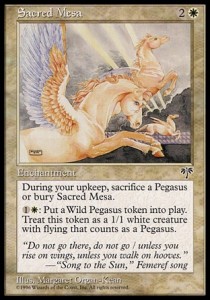
When building a deck, it is important to remember what you want to see later as the game draws on, then to build with that goal in mind. Starting with a core game plan or ethos will help you decide what colors to play, as well. More important that victory is expressing what form you want that victory to take: do you want to overwhelm the opponent with flying horses, or with big beasts? The choice is yours.
Here’s a familiar scene: you’ve logged onto Cardshark, a freshly-deposited Best Buy paycheck on your bank card, ready to buy the last singles you need to crush the casuals at FNM next week. You get to the rares on your list, and recoil in horror as you realize a card that was fifty cents last week suddenly jumped to $2. In a fury, you slam your fist on the desk, lamenting that post you made on MTG Salvation about your sick tech, which drove prices up before you even had a chance to unsleeve your proxies. Suddenly, that 3 for $12 deal on twelve-packs of Mountain Dew seems as though it wasn’t a sound investment after all.
The internet is a double-edged sword: while it makes ordering singles and carving out new strategies easier, you also have to contend against millions of other players looking to get the small edges, many of whom may end up running your own deck against you before it makes its debut under your guidance. Ultimately, your success is built on cost-benefit tradeoffs: are you willing to trade your deck concept for those two or three cards that will push it over the top?
The same is true once you get into an actual game. Even if you can afford to build the deck, can you afford your spells? While Wizards of the Coast has shown some mercy by keeping basic land prices dirt-cheap, ostensibly so you have a chance of playing at all, many of the best lands are non-basic and suitably expensive.
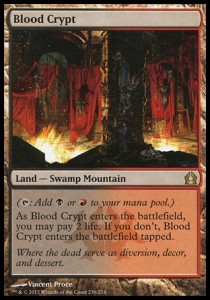
This is where you can carve a niche by saving money on mana to spend on spells. Cards like [card]Urborg Volcano[/card] offer the same benefits as Blood Crypt, but at a much lower cost. Trade a turn for 2 life and $10? That’s a fair trade on any day: there is no point in giving your opponents free cards (e.g. [card]Shock[/card]), especially when you’re trying to save your resources.
Many lament the practice of opening booster packs to score specific singles, but these players often do not understand cost-benefit ratios and how packs are structured. These players often overlook the three uncommons and eleven commons in an effort to score rares, assuming they are the best cards available and often filling their decks with 60 rares in a vain attempt to “be competitive.” The savvy player uses all the tools available to them, finding uses for cards oft-overlooked, only to dominate the competition because their opponents are simply unprepared for the deluge of cards they didn’t see a use for.
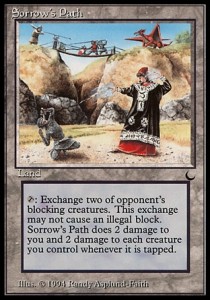
Someone else’s trash is your treasure, if you put your mind to finding a use for it. When you do, it’s your opponent’s cards that will seem like trash.
It’s 11:59 PM and the GPT is tomorrow morning. You have in front of you two items, seemingly meaningless to the casual observer, but monumentous for yourself.
To your left is a deck box containing the brew you plan on playing tomorrow, and with it the decision to get some more testing done.
To your right is a coupon for Denny’s, and it’s only good until 3 AM.
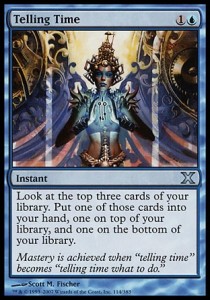
Depending on how hungry you are right now, the choice is obvious. But it isn’t always: what if you want to test, but your friend Joey absolutely hasn’t shut up about food for like three hours now? Joey loaned you cards for your deck, but on the other hand Joey is a fat fuck who has to eat like all the damn time.
Joey is an example of a person you shouldn’t hang out with. On your journey to winning more, you can’t let Joey’s stomach get in the way of that delicious testing. Bill, on the other hand, has a coupon for Domino’s and figures that solves both problems — but he wants you to order because his phone is dead, putting your testing in jeopardy even though Bill appears at first to be a trusted ally. You’ve just lost a precious twenty minutes of testing because you were sorting out the order and then your phone died midway through so you have to plug it in and start all over. Bill forgot his charger at home of course, so by taking his suggestion you’ve gotten in your own way.
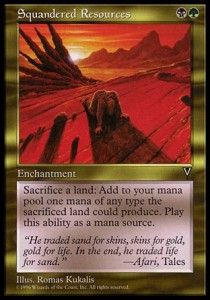
If your true goal is to get testing done, both Joey and Bill are adversaries who seek only to undermine your testing with selfish desires, like eating dinner. Your victory will provide enough sustenance, and your morning hunger pangs will be sated by the tears of the fallen you leave in your wake.
When you have a goal, nothing can come between it and you, or you are setting yourself up for failure later.
This seems simple — it’s something you do every turn! But did you know that there are ways to turn this mundane action into a great source of card advantage, even when you aren’t drawing cards? For example, you can select to scry 2 instead, which is strictly better than drawing a card blindly: if you will, imagine the card you need in your mind, but may not need it right now. You can bank on the following turn’s needs with some simple planning, and after you get used to scrying 2 instead, you’ll feel like you’re cheating because of how much more valuable you’ve made your future draws.
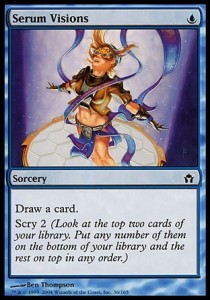
If you’re unfamiliar with Mike Flores’ Peabody-winning article The Philosophy of Fire, I’ll summarize: one red mana is worth two damage, e.g. [card]Shock[/card], but unfortunately I stopped reading before he explained what one blue mana was worth so I’m going with Serum Visions (I immediately grabbed a stack of Shocks, 56 other cards, and put the theory to the test at FNM that night. I got disqualified because the other 56 cards were also Shocks, but I did get a participation promo.)
In a subsequent article, Critical Mass, he posted a decklist that featured [card]Keiga, the Tide Star[/card], then wondered why his deck was great: because Keiga, the Tide Star is easily the closest replacement for Serum Visions in the deck. For five extra colorless, and it’s a flying 5/5, it is exactly like one mana for drawing a card and scrying 2: when Keiga dies, he likely traded for another card on the way down (a creature in combat; a kill spell; the Legendary rule), and got to steal a creature to replace itself as well.
That’s three cards — just like Serum Visions. In other words, Keiga is a Serum Visions on legs.

But what if you don’t draw Keiga?
When it comes to winning games of Magic, your plays are ultimately defined by how many cards you drew. But even more important than drawing cards is what you choose to do with them. While the best cards in the game are ones that draw you more cards, it’s also important to eventually defeat your opponent.
At one point, these two cards were identical. Take a moment to consider these cards if they had been printed back in 1993, when Magic first released.
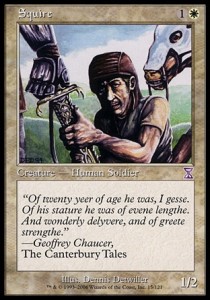
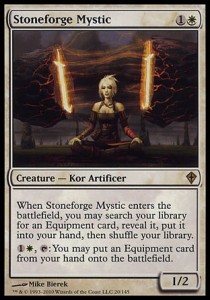
Back in 1993, Stoneforge Mystic is functionally blank, because Equipment cards wouldn’t exist for another ten years. Mystic is considered “a mistake” in terms of power level, but Squire is largely considered unplayable, even though they both cost 1W for a 1/2 body.
This is a fatal error in deck building. Rather than rest on the notion that Squire is and will continue to be bad, always, instead flip the question on its head: how good does the text in the box have to be before a 1/2 for 1W is playable?
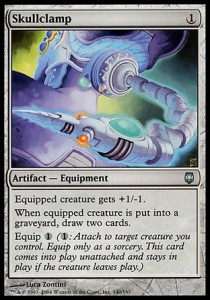
Now let’s consider another “mistake”: Tarmogoyf. By the Squire test, Tarmogoyf is imminently unplayable; he’s 1G for a 0/1, if we ignore the text in the box. But as current secondary-market prices and multiple reprints attest, that text is worth about $150, give or take.
Mindblowing, until you consider that Squire’s text comes from The Canterbury Tales, a book which sold for $7.5 million at auction. Squire takes a large portion of its text from the book, which is over 200,000 words — meaning each word is worth approximately $37.50. Suddenly, Tarmogoyf seems as quaint as sixpence next to Squire’s incredible value.
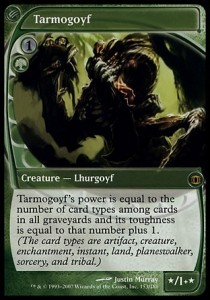
Sometimes we have to take cards in historical context to understand why they are secretly powerful. Chaucer, the author of Canterbury Tales, did not write about Stoneforge Mystic, or about Tarmogoyf, but instead the secret power of the game he had discovered and revealed to us hundreds of years ago: Squire is truly a juggernaut from the past.
Only by knowing the history of the game as well as the history of the authors and geniuses who came before the game can you truly unlock your deckbuilding potential.